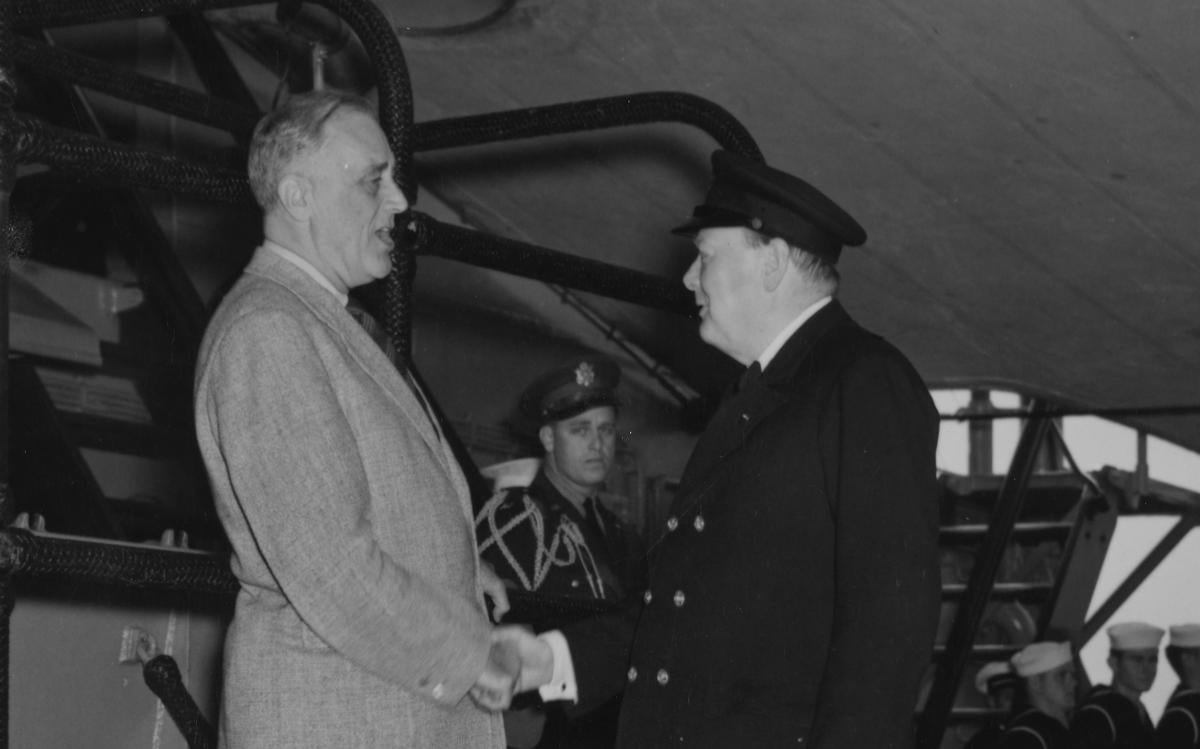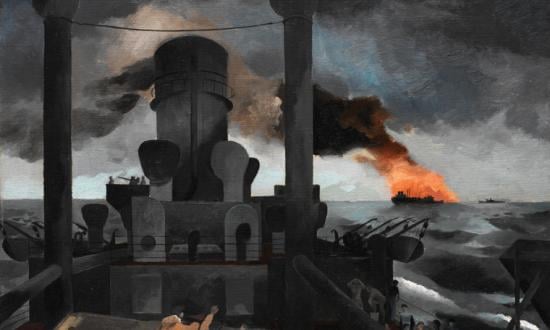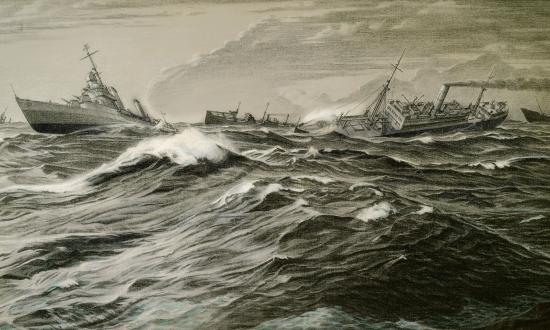At the beginning of World War II, Britain had the most powerful navy in the world, however, the Royal Navy struggled to maintain maritime superiority in the face of the German U-boat threat. Britain and the United States negotiated the destroyers-for-bases deal that kept Britain in the war and helped turn the tide in World War II.
Britain Asks for Help
By the time Winston Churchill became Prime Minister of Britain on 10 May 1940, Germany had already invaded Poland, Denmark, and Norway, and, on that very morning, began its invasion of the Netherlands, Luxembourg, Belgium, and France. Germany’s U-boats were decimating merchant shipping, trying to starve Britain into submission by sinking ships carrying food and other vital goods to the island. At the same time, Britain also feared a cross-channel invasion from Germany.
The Royal Navy had two vital missions: protecting merchant shipping and guarding against a cross-channel invasion, both of which required destroyers. Eleven of Britain’s 179 destroyers had been lost since the beginning of the war.1 New destroyers were being built in British shipyards, but they would not be ready until 1941.2 Despite having the most powerful fleet in the world, Britain found itself in need of help from international partners to maintain maritime superiority. On 15 May 1940, Winston Churchill asked U.S. President Franklin D. Roosevelt for “the loan of forty or fifty of your older destroyers.”3
The United States is Wary
Though Roosevelt may have wanted to help, he turned Churchill down. Fifty ships represented 20 percent of the U.S. Navy’s destroyer force at that time.4 Initially, Roosevelt may have had a hard time seeing past the idea that the United States would be losing 50 destroyers—ships the United States would need to counter the Nazi threat on its own behalf, if it came to that. If this had been a traditional distributive bargaining, or win-lose, negotiation, the United States would have tried to get as much money as possible in exchange for the destroyers.5 At that point in the war, however, Britain could not afford to pay money for the ships.
Many factors were working against the deal on the U.S. side. To begin with, the United States was a neutral party—it had not yet entered the war. U.S. law at that time seemed to prohibit the transfer of arms to a belligerent. Public opinion in America was mixed: Many people were against Hitler’s aggression in Europe, but there was a sizeable isolationist sentiment. Roosevelt was campaigning for an unprecedented third term and was treading lightly.
Most of all, Roosevelt feared that Britain would not be able to resist a German invasion. If the United States gave Britain 50 destroyers, what would happen to them if Britain fell?
Churchill’s Back-Up Plan
Churchill refused to give up on the idea of U.S. destroyers and ultimately bringing the United States into the war. However, in any situation it is a good idea to have a back-up plan or, in negotiation terms, a best alternative to a negotiated agreement (BATNA).6 Churchill’s BATNA was to try to persuade other countries with large navies to either join the Allies or to remain neutral.
The 1939 edition of Jane’s Fighting Ships lists the countries with the largest navies in the world as: 1) Britain, 2) the United States, 3) Japan, 4) France, 5) Italy, 6) Germany, and 7) the Soviet Union.7 To counter the German U-boat threat and maintain maritime superiority, Britain would need help from one or more large navies.
Churchill considered Japan. Biographer Martin Gilbert writes that on 17 May 1940, Churchill went “to the Japanese Embassy for lunch with the Ambassador, Shigemitsu, toward whose Government the utmost amiability appeared necessary, despite its military dominance in China.”8 No headway was made with Japan’s third-largest navy.
The Soviet Union had signed a nonaggression pact with Germany the previous August, so no attempt was made to try to get their seventh-largest navy to join the allies.
Churchill held no hope that Italy would join the allies, but he did try to persuade Mussolini to keep Italy’s fifth-largest navy neutral.9 His efforts failed when Italy entered the war on Germany’s side on 10 June 1940.
Britain’s last remaining BATNA was to keep its ally France—or at least France’s navy—in the war. In early June, France was in serious danger of falling. At the final meeting of the Anglo-French Supreme War Council on 12 June 1940, Churchill approached Admiral François Darlan, Commander in Chief of the French Navy. “Darlan,” he said, “I hope you will never surrender the Fleet.” Admiral Darlan replied, “There is no question of doing so; it would be contrary to our naval tradition and honour.”10
The German army marched into Paris on 14 June 1940. Two days later, France asked Germany for an armistice, going against its agreement with Britain not to seek a separate peace. Britain now stood alone against Nazi Germany.
After the fall of France, Churchill held out hope that the French fleet would sail for Britain and continue to resist the Nazis. Admiral Darlan’s promise had been reiterated on more than one occasion.11 But for more than two weeks after France asked Germany for an armistice, the French fleet—the fourth largest in the world—made no move to join the British. Britain was running out of options for acquiring the ships necessary to maintain their maritime superiority.
Tragedy at Oran
Churchill decided to take action. On 3 July 1940, he initiated Operation Catapult, which “comprised the simultaneous seizure, control, or effective disablement or destruction of all the accessible French Fleet.”12 At ports outside France, Royal Navy officers presented their French counterparts with four choices: sail with the British fleet and continue to fight, sail with reduced crews for a British port, sail for ports in the West Indies and disarm, or be destroyed.13
At Portsmouth and Plymouth, England, the British took control of two French battleships, four light cruisers, eight destroyers, some submarines, and hundreds of smaller craft.14 Crews willingly came ashore, except on board the submarine Surcouf, on which three lives were lost during the seizure. At Alexandria, Egypt, the French admiral in charge agreed to disable his fleet—one battleship, four cruisers, and several smaller ships.15
Sadly, the situation was very different with the French ships at Algeria. At the port of Mers-el-Kebir, near Oran, two French battlecruisers, two battleships, and several other ships were in port when Royal Navy Admiral James Somerville presented French Admiral Marcel-Bruno Gensoul with the terms.16 Gensoul was given six hours to decide. Somehow, the option to sail his ships to the West Indies and disarm was omitted from the alternatives presented to him, but in any event, Gensoul refused all terms. British intelligence intercepted a message from Darlan’s chief of staff telling Gensoul, “You are to answer force with force.”17
The night before, Britain’s First Sea Lord, Admiral Dudley Pound, had sent Admiral Somerville a message, which read, “You are charged with one of the most disagreeable and difficult tasks that a British Admiral has ever been faced with, but we have complete confidence in you and rely on you to carry it out relentlessly.”18 When Gensoul’s six-hour window was up, the Royal Navy fired upon the French ships. As Martin Gilbert writes:
It was at 5:55 p.m. that Somerville gave the order to open fire, and within five minutes he was himself heavily engaged. At 6:04 p.m. he ordered the cease fire in order to give the French crews the opportunity to leave their ships. The battle had lasted nine minutes. The [battleship] Bretagne had blown up. The [battlecruiser] Dunkerque had run aground. The [battleship] Provence was beached. And in those few minutes, more than 1,250 French sailors had been killed.19
Churchill was deeply upset to learn of the tragedy at Oran, but he knew allowing Germany to have the French fleet might well have meant the end for Britain.20
Though Operation Catapult had resulted in some free French ships joining Britain, the U.K. still desperately needed those U.S. destroyers. (An additional 18 British destroyers had been lost since Churchill’s first appeal.)21 On 31 July 1940, Churchill told Roosevelt, “Mr. President, with great respect I must tell you that in the long history of the world this is a thing to do now.”22
A Turning Point in the Negotiations
With the fall of France, the United States’ own BATNA had become greatly reduced. Now Britain was the only thing standing between Hitler and the United States. Roosevelt and his administration worked to address the many roadblocks to the deal. One of Roosevelt’s advisors pointed out that giving the ships to Britain could actually improve U.S. national security.23 It would allow the ships to be used to fight Germany immediately, whereas keeping them would have meant Germany would be more likely to defeat Britain and come after the United States next. This realization was the key turning point in the deal. Once the situation was framed this way—that giving the ships away was in both countries’ mutual interest—Roosevelt began to envision how a win-win deal could be done.
At some point, the suggestion was made to Roosevelt to ask for land in British colonies in the Caribbean and Atlantic for use as U.S. naval and air bases. Such bases would help protect the U.S. eastern seaboard, as well as the Panama Canal. This plan would have appealed to Roosevelt, who in early 1938 had told Congress, “Adequate defense means that for the protection not only of our coasts but also of our communities far removed from the coast, we must keep any potential enemy many hundreds of miles away from our continental limits.”24
During a meeting between Roosevelt and his cabinet on 02 August 1940, there was a “long discussion in regard to devising ways and means to sell directly or indirectly fifty or sixty World War old destroyers to Great Britain. It was the general opinion, without any dissenting voice, that the survival of the British Isles under German attack might very possibly depend on their getting these destroyers.”25 Dean Acheson and other prominent lawyers penned an op-ed in The New York Times on 11 August 1940, arguing to the public that there were no legal impediments to the deal and that it could be done by executive action. They also pointed out, “In the present state of the world, the maintenance of British sea power is of inestimable advantage to us in terms of our own national defense” and “the release of at least fifty of our over-age destroyers for sale to Great Britain is not only compatible with, but is vitally important to, the safeguarding of our own national defense.”26
Roosevelt’s political problems were eased when Wendell Willkie became the Republican nominee for president, instead of an isolationist candidate. Willkie agreed not to make the destroyer deal an issue in the campaign.27
Outcomes of the Deal
Once the United States realized that giving Britain the destroyers would benefit both sides, negotiation began in earnest. Britain’s primary interest was getting more destroyers to fight Germany. The United States was interested in gaining bases in the Western Atlantic from which to defend U.S. shores. Each side’s overarching goal, however, was to stop Hitler.
In the end, Britain got 50 World War I–era destroyers — known as “four-stackers” or “four-pipers” — from the United States.28 The ships were old, outmoded, and had poor handling qualities, but as Admiral George Creasy, British Director of Anti-Submarine Warfare, later said, “Any destroyer that could steam, shoot, and drop depth charges was worth its weight in gold … in the autumn of 1940.”29 The destroyers had a powerful effect on the morale of the British people, who, in their darkest hour, felt that the American people supported them. On 06 September 1940, the first eight destroyers, fully loaded with ammunition, food, and other stores, sailed for Canada, where the ships were transferred to Royal Navy crews.30 In giving up the destroyers, the United States gained a stronger ally who would fight Hitler all the more effectively before it entered the war.
The United States got bases in Newfoundland, Bermuda, the Bahamas, Jamaica, St. Lucia, Trinidad, Antigua, and British Guiana for its defense.31 Churchill obtained agreement from each colony to site a U.S. base within their territory. Transferring sovereignty of the land was off the table, but the compromise was 99-year leases.32 Long-term leases allowed the United States to make capital improvements to maximize each base’s warfighting capabilities. Construction of the bases began within months.33 The bases enabled the United States to protect the Western Hemisphere from looming Nazi aggression—keeping the enemy away from its continental limits, as Roosevelt had proposed in 1938. The bases did not just protect the United States, but the British Colonies, the Panama Canal, and all of North and South America.
There were intangibles that each side gained as well. For political reasons, Churchill wanted the bases to be gifts freely given to the American people, while Roosevelt wanted the destroyers-for-bases deal characterized as a quid pro quo.34 The two sides reached a compromise—the bases in Newfoundland and Bermuda were characterized as outright gifts as gestures of goodwill, while the other bases were exchanged for the ships.
Roosevelt wanted the U.K. to promise to send its fleet to America if Britain fell to Germany.35 Churchill could not agree to this. He was being asked to give the same promise to Roosevelt that France’s Admiral Darlan had given him—to turn over his fleet to an ally in the event his country was conquered by Germany. In his mind, Darlan had reneged on that promise, forcing Britain to attack her former ally at Oran.36 More important, Churchill could not risk the blow to British morale if he were to even entertain the possibility of losing to Germany by making such a promise.
Perhaps because of what happened at Oran, Roosevelt no longer needed an explicit promise from Churchill. (Months later, Roosevelt aide Harry Hopkins told Churchill’s Private Secretary Jock Colville that Oran had convinced Roosevelt that Britain would continue the fight.)37 Instead, Roosevelt asked Churchill to reiterate his remarks from his speech to Parliament on 04 June 1940, which Churchill happily did. That famous speech ends:
We shall fight on the beaches, we shall fight on the landing grounds, we shall fight in the fields and in the streets, we shall fight in the hills; we shall never surrender, and even if, which I do not for a moment believe, this island or a large part of it were subjugated and starving, then our Empire beyond the seas, armed and guarded by the British Fleet, would carry on the struggle, until, in God's good time, the new world, with all its power and might, steps forth to the rescue and the liberation of the old.38
The destroyers-for-bases deal showed that the United States and Britain shared what Churchill later called the “special relationship.” The deal gave Britain the means and faith to keep fighting. Even though it would be more than a year before the United States joined the war, it was no longer a neutral country; it was firmly on Britain’s side. In March 1941, the Lend-Lease Act was approved by Congress to send Britain even more material aid. The United States entered the war following the Japanese attack on Pearl Harbor on 07 December 1941.
The destroyers-for-bases deal shows that working with allies yields greater results than the United States can achieve alone. Instead of focusing strictly on what they would lose or gain by transferring the destroyers, the United States and Britain found a way to enhance both countries’ national security.
1. Total number of British destroyers from Francis E. McMurtrie, ed., Jane’s Fighting Ships 1939 (1939; rpt. Newton Abbot, Devon, England: David & Charles Reprints, 1971), 63–71. Number of destroyers lost from Naval-History.net, naval-history.net/WW2BritishLosses1Major.htm.
2. Winston S. Churchill, The Second World War, Volume II: Their Finest Hour (Boston: Mariner-Houghton Mifflin, 1985), 353.
3. Churchill, The Second World War, Volume II, 353.
4. McMurtrie, Jane’s Fighting Ships 1939, 499–504.
5. Roy J. Lewicki and others, Negotiation 4th ed. (New York: Irwin-McGraw-Hill, 2003), 74–112.
6. Roger Fisher, William Ury, and Bruce Patton, Getting to Yes: Negotiating Agreement Without Giving In 3rd ed. (New York: Penguin, 2011), 99–108.
7. McMurtrie, Jane’s Fighting Ships 1939, viii.
8. Martin Gilbert, Winston S. Churchill, Volume VI: Finest Hour, 1939-1941 (1983; rpt. Hillsdale, MI: Hillsdale College Press, 2018), 357.
9. Gilbert, Winston S. Churchill, Volume VI, 341–42.
10. Gilbert, 520 (quoted Darlan letter to Churchill dated 04 December 1942).
11. Gilbert, 568, 596.
12. Churchill, The Second World War, Volume II, 206.
13. Churchill, 208–9.
14. Churchill, 206–7.
15. Churchill, 206, and Gilbert, Winston S. Churchill, Volume VI, 634.
16. Churchill, The Second World War, Volume II, 206.
17. Gilbert, Winston S. Churchill, Volume VI, 634, 636.
18. Gilbert, 633.
19. Gilbert, 637.
20. Martin Gilbert, interviewed in Secrets of the Dead: Churchill’s Deadly Decision, WNET/Public Broadcasting Service, 11 May 2010, pbs.org/wnet/secrets/churchills-deadly-decision-watch-the-full-episode/620/.
21. Naval-History.net, naval-history.net/WW2BritishLosses1Major.htm.
22. Warren F. Kimball, ed., Churchill & Roosevelt, The Complete Correspondence, Volume I: Alliance Emerging (Princeton, NJ: Princeton Univ. Press, 1987), 57.
23. William R. Casto, “Advising Presidents: Robert Jackson and the Destroyers-for-Bases Deal,” American Journal of Legal History 52.1 (2012): 56–61.
24. David Kaiser, No End Save Victory: How FDR Led the Nation Into War (New York: Basic Books, 2014), 39.
25. Elliott Roosevelt, ed., F.D.R.: His Personal Letters, 1928-1945, Volume II (New York: Duell, Sloan and Pearce, 1950), 1,050.
26. Dean Acheson and others, “No Legal Bar Seen to Transfer of Destroyers,” The New York Times, 11 August 1940, 8–9.
27. Elliott Roosevelt, F.D.R.: His Personal Letters, 1,051–52.
28. Daniel S. Greenberg, “U.S. Destroyers for British Bases: Fifty Old Ships Go to War,” United States Naval Institute Proceedings 88, no. 11 (November 1962): 70–83.
29. Philip Goodhart, Fifty Ships that Saved the World (New York: Doubleday, 1965), 237.
30. Goodhart, Fifty Ships, 193–95.
31. Kimball, Churchill & Roosevelt, 68.
32. Churchill, The Second World War, Volume II, 362.
33. Navy Department, Building the Navy's Bases in World War II: History of the Bureau of Yards and Docks and the Civil Engineer Corps 1940-1946, (Washington, DC: U.S. Government Printing Officer, 1947), chapters 18–19.
34. Churchill, The Second World War, Volume II, 362–63.
35. Kimball, Churchill & Roosevelt, 59.
36. Churchill, The Second World War, Volume II, 201–2.
37.Warren Tute, The Deadly Stroke (London: Coward, McCann & Geoghegan, 1973), 17. Quoted in Gilbert, Winston S. Churchill, Volume VI, 643–44.
38. Winston S. Churchill, War Situation, House of Commons Sitting of 04 June 1940, https://api.parliament.uk/historic-hansard/commons/1940/jun/04/war-situation.






